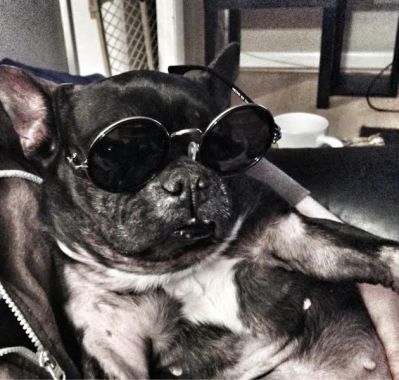Eye Health and Frenchies

Our Frenchies’ eyes are frequently called “bumpers” because they are protuberant on the sides and front and there is not much snout to protect them. A dash into a rose bush, a hostile meeting with a cat—well, you can imagine the many ways a Frenchie could injure an eye! If your dog’s eye is red, if he’s scratching it, if he’s squinting, if it is teary or there are any spots on the surface of the eye—get to the vet without delay.
Frenchies get eye ulcers very frequently—ask the owner of an elderly Frenchie if their dog has had one, and he’s likely to say, “Oh, yes!” Eye ulcers are generally caused by an injury to the eye or even by dry eye. You will not likely be able to see the injury, but your dog’s eye may be watering or your dog might be squinting or rubbing his eye. Have you ever scratched your cornea? Then you know how much it hurts! Untreated eye ulcers can lead to infection, blindness, and, in the worst cases, your dog can even lose his eye.
|
Zydeco lost an eye Nanna has dry eye
|
We’ve had many, many foster dogs who’ve come to us with untreated eye ulcers. Some have had to lose their eyes, some are blind or vision-impaired. There are various degrees of ulcers, ranging from relatively mild to very serious, as you can imagine. If your dog is squinting or rubbing her eye, don’t wait—get to the vet. This injury will require the hard-plastic cone of shame for at least a few days. Stock up on treats.
Another very common problem for Frenchies is dry eye, and as mentioned above, dry eye is one of the causes of corneal ulcers in Frenchies. Dry eye means tears aren’t being produced properly, whether from injury, age, or some other cause. You may know your dog is having trouble in a few different ways, but sometimes there will be a thick or gooey discharge instead of proper tears. Or your dog’s eye might look cloudy or not have the usual bright appearance. The fix for dry eye is easy, but you must be diligent with giving eye drops or applying the ointment your vet will prescribe. Over the counter eye drops or saline are not going to work, unfortunately.
Cherry eye is the condition that looks most dire but may be least dangerous in fact. You’ll notice a cherry-red bulge in the corner of your dog’s eye. It’s caused by the prolapse of the third membrane of the eye. Sometimes you can press the bulge gently back into place, but it will almost certainly reappear at some point, and you should make a vet appointment to discuss your dog’s specific situation.
Pigmentary keratitis can be hard to see, but it often means that some constant or chronic irritation to the surface of the eye has caused discoloration or scar tissue deposits on the eye. Our available dog Lana currently suffers from this condition, and she is visually impaired as a consequence. There are many reasons for that constant scarring, including dry eye, including a condition called entropion, where a number of eyelashes form on the inside of the eyelid. There’s a surgery to take care of serious cases, or vets can pluck the lashes every few weeks. There are a number of other constant irritants to the eye, so if you see a brownish spot or patch on the surface of your dog’s eye or spreading over the conjunctiva or white part, mention it to your vet.
Owning a Frenchie means constant vigilance! Between palate and tail, a lot can go wrong, and many Frenchie owners joke about sending our vet's kids to college--or at least a study-abroad semester--while ruefully offering up our credit cards at the counter. Understanding that your Frenchie will likely require more medical attention, and in the long run will very likely be more expensive than another breed, may help you decide whether a Frenchie is for you.








